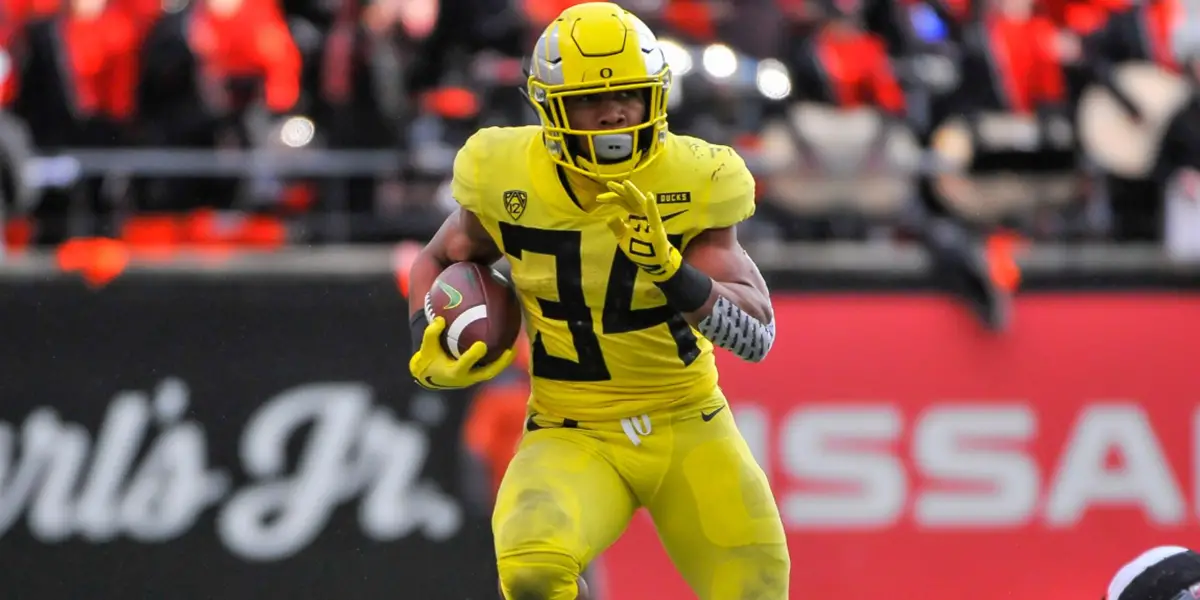The evolution of recruiting has rocked college football. Never have fans been so heavily invested in the lives of high school athletes, tracking their every tweet, interview and lunch stop until they sign their letters of intent.
In this recruiting-dominated landscape, it’s easy to forget that acquiring top-tier talent on paper doesn’t guarantee success.
So what does this mean for Oregon? Mario Cristobal has upped the program’s recruiting game significantly, positioning it for top-10 classes for the foreseeable future. Does that mean that title runs and playoff berths are soon to follow? Or are fans putting too much stock into recruiting rankings, and should they take a wait-and-see approach despite Oregon’s trailblazing recruiting efforts?
Do Recruiting Rankings Matter?
Let’s get this out of the way: recruiting rankings matter. It’s practically impossible to win a championship without a roster of blue-chip recruits. Additionally, four- and five-star prospects are much surer bets than their lower-ranked counterparts.
According to SBNation’s “Blue-Chip Ratio” Study, since 2005 (and perhaps earlier), no program with less than 50 percent of its roster as blue-chip players (four- and five-star recruits) has won a national championship. There have been close calls (like Auburn in 2010, which may or may not fall short of the criterion depending on the recruiting service), but overwhelmingly, a program is more likely to win a title if the majority of its roster is made up of elite recruits.
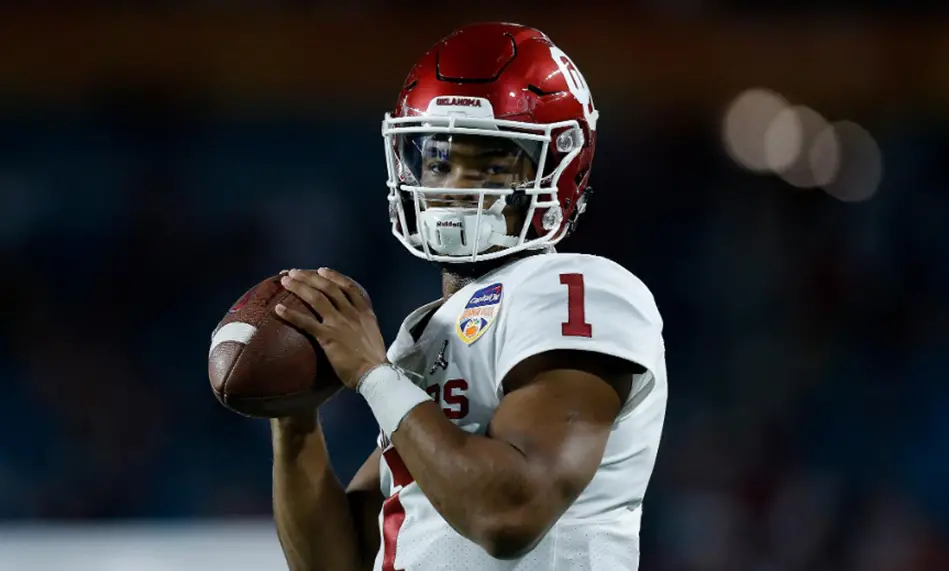
Kyler Murray, a former five-star, was the first pick in the 2019 NFL Draft.
And for those who wonder whether it’s really worth the headache chasing those “diva” five-star prospects — it is. A 247Sports article pointed out that, despite accounting for just 11 percent of the college football talent pool, four- and five-stars made up 53% of the players drafted in the first round of the 2019 NFL draft. SBNation came to a similar conclusion when analyzing the 2014 NFL draft, determining that four- and five-stars were nearly one thousand percent more likely to be drafted in the first round than lower-rated players.
Recruiting rankings aren’t insignificant, not in the slightest. There’s a direct correlation between getting elite prospects and on-field success. Recruiting gurus aren’t just throwing darts at dartboards. The industry is about as accurate as is possible with the resources available. High-ranking players usually deliver, at least way more often than low-ranking players do.
But there have been exceptions. And when enough under-the-radar prospects team up with the right coaching staff, the gap between the “haves” and “have nots” shrinks tremendously. In some cases, the board flips entirely.
Good Classes Don’t Guarantee Success
Although programs that consistently recruit well according to industry-generated rankings have a championship-level ceiling year in and year out, their floors can be shockingly low. A top-25 class may look good on paper, but good teams are more than a collection of paper talent. For recruiting success to translate to the field, the players that are brought in must be good fits for the system they’re entering. Then, they need to be developed and coached. Personalities have to be managed, and the right culture has to be established.
Some programs will sign top-25 classes routinely, simply because of their pedigree or location. But not all of these programs play as well as they recruit. Meanwhile, other programs with middle-of-the-pack recruiting classes have managed to match, or even best, these storied schools on the field.
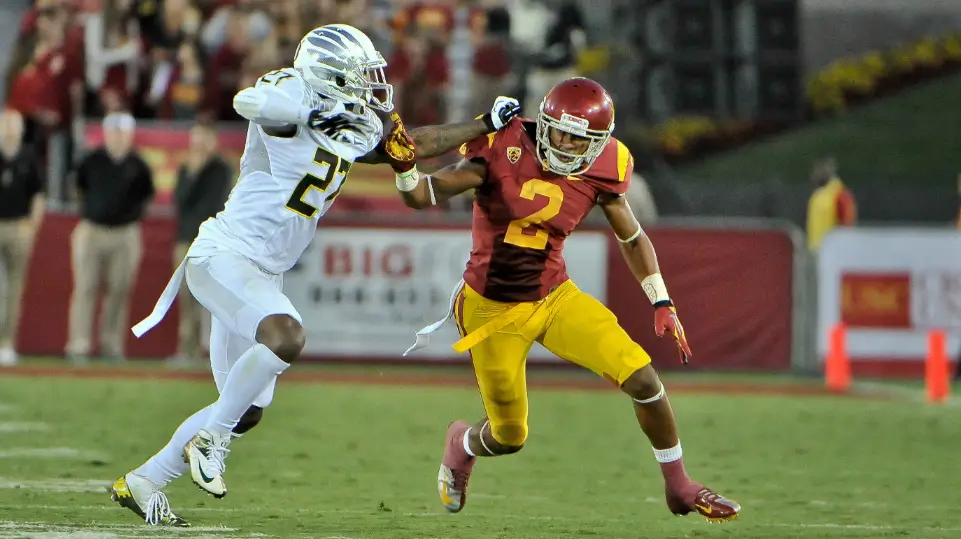
Oregon has bullied USC for much of the decade.
Oregon fans are familiar with USC’s relative struggles, despite signing top-25 classes (and some top-five classes) like they’re going out of style. The Trojans have gone 43-23 since 2014. That’s not a bad record, but when compared to Kyle Wittingham’s Utah Utes, which have gone 42-22 in the same span, it’s underwhelming. USC has had a top-25 class in every cycle since Utah joined the Pac-12. On the other hand, the Utes haven’t had a single class crack the top-25 during that period. According to the industry’s metrics, the two shouldn’t even be in the same discussion.
Texas is in the same boat as USC. The Longhorns have been historically disappointing while schools like TCU have had much more recent success. The recruiting disparity between the two programs is significant (TCU has just two top-25 classes since 2010 while Texas has 10), but on the field the Horned Frogs have outperformed Texas (TCU is 58-33 since joining the Big 12 while Texas is 50-40 in the same span).
And then there’s Wisconsin, the Big 10’s not-so-little “engine that could.” The Badgers have been anything but flashy on the recruiting trail, yet they’ve been one of the most consistently dominant programs in the country. They’ve won their division five times since 2011, making it to four New Year’s Six or BCS bowl games in that span despite not landing a top-25 recruiting class in the 2010s.

Jonathan Taylor, 2018’s rushing leader, was a three-star recruit.
So what’s the reasoning behind these “exceptions”? Clearly, teams shouldn’t try to avoid big-name targets. But maybe, with so much focus being placed on signing the industry’s idea of top talent, the value of good scouting and expert-level coaching is being overlooked.
Recruiting Rankings Are Flawed
Recruiting rankings are decent indicators of a team’s talent level, but they’re not perfect. The ranking system is inherently flawed, despite the industry’s best efforts to make it as accurate as possible.
With thousands of prospects littered across countless schools, cities, states and even countries, it’s impossible to accurately grade the abilities of each and every recruit. So evaluators limit their searches to the players who have the best legitimate tape available, have played against the best competition and have the most easily identifiable positive traits, like size and athletic measurables.
Ever wonder why the South always has so many blue-chip prospects? No, it’s not because the SEC has an exclusive contract with a recruiting service. It’s because there are so many football players in that region that play against top competition throughout their high school careers, have reliable footage and have verified measurables. Experts choose to look for “knowns” and will take the risk of misidentifying or under-ranking “unkowns.” It’s a probability game, and the numbers say to look for the sure thing.
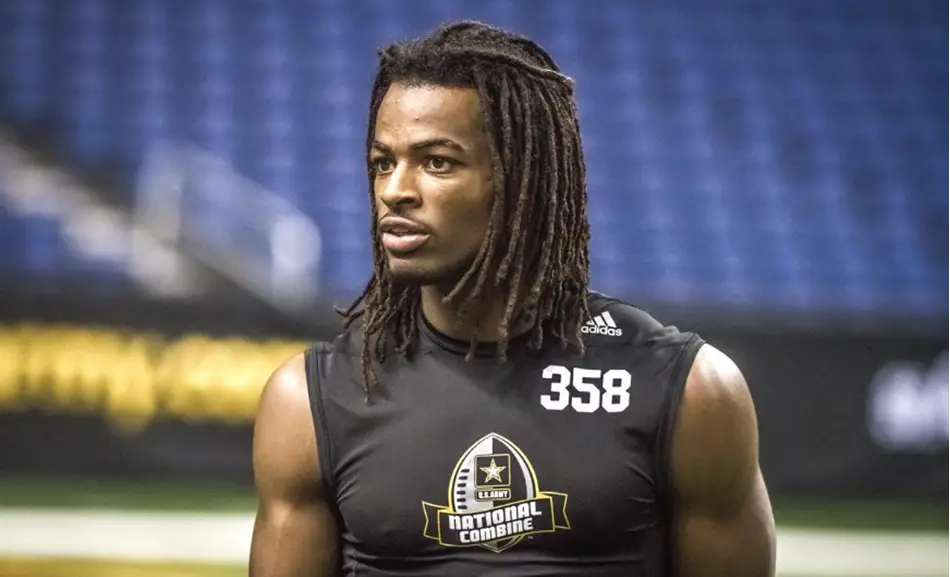
Players like former five-star running back Najee Harris grade highly for their athleticism and size.
But that also means that players slip through the cracks. Not everyone has the resources to make a decent highlight tape or attend a regional 7-on-7 competition. Many prospects have frames that aren’t even close to being maxed out in high school, and others play against shoddy competition. This doesn’t mean that they’re bad players, nor that the industry believes so. But it’s a safer bet to go for a prospect who unequivocally checks all the boxes than it is to take a flier on one who does not.
Many of these overlooked players blossom into stars. Josh Allen, T.J. Hockenson and Andre Dillard weren’t even on the radar as high school prospects (all ranked outside of the top one thousand as prospects). But those three, like others before them, developed into elite college players, who out-performed their higher-ranking counterparts on a weekly basis. All three were first-round NFL draft picks in 2019 and are expected to be immediate contributors for needy NFL teams.
Schools like Utah, Wisconsin and TCU build their programs around these under-recruited project players, as they don’t have the luxury of simply passing them over in favor of known commodities. The competition is too stiff. They’re willing to live with the fact that their targets will be ones that bigger programs have reservations about, and they invest in scouting to determine whether those reservations are legitimate or not. Many times, these players are just as good as the more publicized blue-chip prospects, but haven’t had the right platform to showcase their talent. Other times, question marks (like injuries or competition level) hold their rankings back.
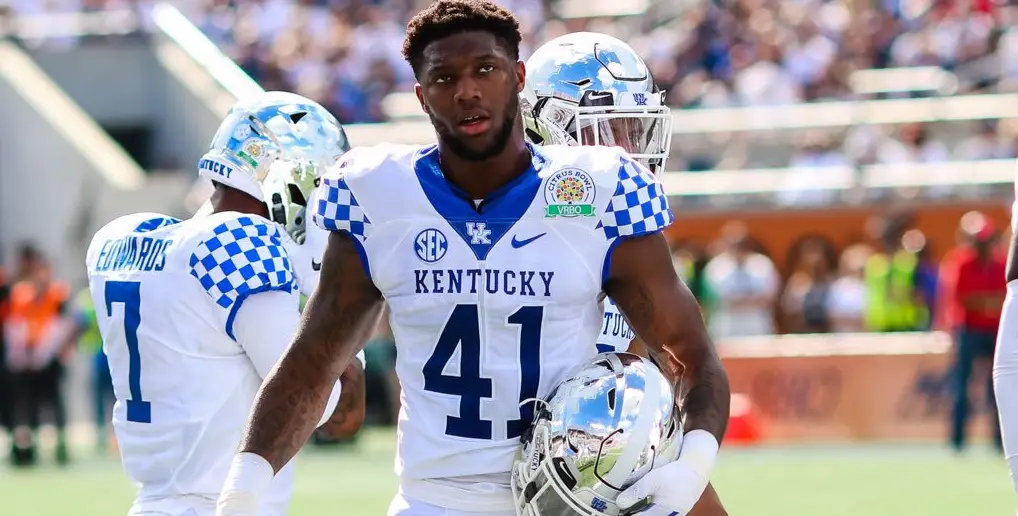
Josh Allen was one of the top pass rushers in college football in 2018.
What’s more, teams that have succeeded with less-than-stellar recruiting classes don’t use the same strategy as the traditional blue bloods, which look for players who fit the “industry mold.” Since those prospects are hard to find and relentlessly fought over by big-name programs, smart lower-tier programs prioritize specific traits that fit within their system and are more abundant. Wisconsin tailored its offense to easily integrate the many available big-bodied linemen found in the Midwest. Utah has had success targeting under-recruited Polynesian players who often develop into pro-ready forces on the defensive line. TCU looks for smart, coachable prospects who can grasp Gary Patterson’s proven scheme.
The success of these teams (and others like them) has proven that it’s not enough to rely solely on industry-generated recruiting rankings to predict a team’s fortunes. While it’s hard for a team without a lot of blue-chip talent to be a playoff contender, it’s not a guarantee that a team with a lot of blue-chip talent will be one, either.
For the Oregon coaching staff and fans alike, this is an important lesson. Signing top-10 classes should not be frowned upon, as it’s a huge sign of growth for the program. Cristobal is a tireless recruiter, and that energy has reinvigorated a faltering Ducks football team. But let the struggles of Pac-12 counterpart USC be a lesson. Acquiring talent and developing it isn’t as straightforward as “winning” signing day.
Sneaky good three-stars can be better producers than consensus five-stars. Some of Oregon’s top players in recent history (Marcus Mariota, LaMichael James, Patrick Chung, Justin Herbert, Kenjon Barner, Hroniss Grasu and Vernon Adams Jr.) didn’t make the blue-chip cut as prospects, but far exceeded their high school rankings by landing in the right system with a coaching staff that put them in a position to succeed. Contrarily, Cameron Colvin, Canton Kaumatule and Thomas Tyner are some examples of five-star recruits that didn’t pan out at the college level.
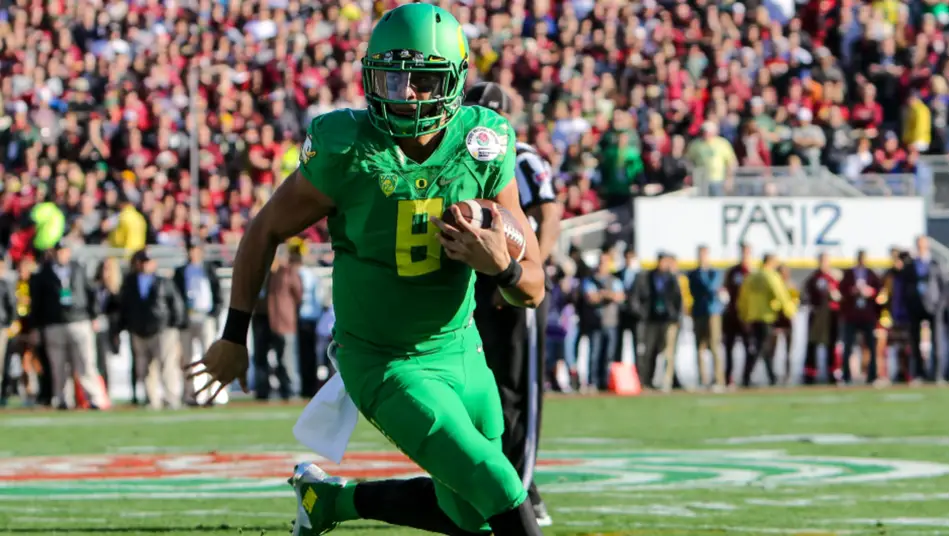
Marcus Mariota was a three-star recruit.
Recruiting top prospects is fine, so long as they’re taken with the understanding that the industry’s rating isn’t gospel. If they have the mentality, skill set and work ethic that the staff is looking for, then by all means, they should be pursued in a heartbeat. But if there’s a no-name, lightly recruited prospect that is sufficiently talented and fits better within the structure of the program, then he should be the priority.
After all, despite all of the five-star players on Alabama’s roster, their best player in 2018 was middle-of-the-pack four-star Quinnen Williams. Oklahoma nearly made it to the national championship with a former walk-on at quarterback. And Oregon won a Rose Bowl in dominant fashion with its three-star Heisman-winning quarterback at the controls.
At the end of the day, when prospects put pen to the paper and lock in their destination for the next four years, their star ratings go out the window. Whether a team finished fourth or 40th in the recruiting rankings is irrelevant when the toe hits leather.
Joshua Whitted
Morgantown, West VirginiaTop Photo by Kevin Cline
 Bob Rodes, the FishDuck.com Volunteer editor for this article, is an IT analyst, software developer and amateur classical pianist in Manchester Tennessee.
Bob Rodes, the FishDuck.com Volunteer editor for this article, is an IT analyst, software developer and amateur classical pianist in Manchester Tennessee.
Related Articles:
Oregon Enters Playoffs Better Off Than Last Year
Will The Coaching Carousel Kill Oregon's CFP Chances?
The Playoff Formula Hasn't Changed
Oregon Aims to Bury Dawgs, Punch Playoff Ticket in Rivalry Clash
Huskies Are the New Beavers, Stay In Your Lane Kiffin, and the Civil Apple Cup War
Oregon Football: The X-Factor Vs. Washington
Joshua is an adopted Duck fanatic, originally hailing from southwestern Pennsylvania. His love for the University of Oregon began as a young child when he became mesmerized by the flashy uniforms and explosive offenses of the Chip Kelly era, and now, he follows the team religiously. His fondest memory of the team is seeing De’Anthony Thomas race past Wisconsin defenders back in the 2012 Rose Bowl. A true football enthusiast, Joshua loves studying the intricacies of the game, and he aspires to become a professional sports journalist. Joshua now resides in Morgantown, West Virginia where he works in customer service. When he’s not watching Oregon replays, Joshua loves reading, writing, and spending time with his family. Contact: whittedjd@gmail.com

